Cover Story: Chef Explores the Regional Chaats of India Through Train Journeys
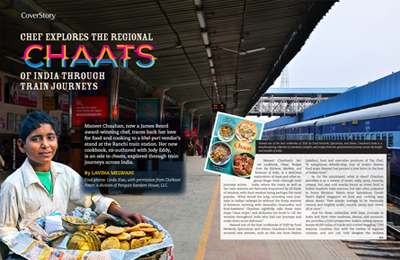
Maneet Chauhan, now a James Beard award-winning chef, traces back her love for food and cooking to a bhel-puri vendor’s stand at the Ranchi train station. Her new cookbook, co-authored with Jody Eddy, is an ode to chaats, explored through train journeys across India.
Food photos: Linda Xiao, with permission from Clarkson Potter, a division of Penguin Random House, LLC.
(Photo: Stock photography)
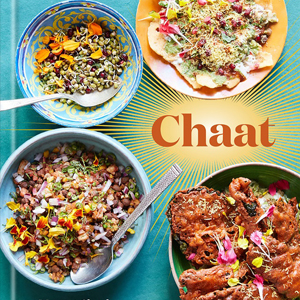
Maneet Chauhan’s latest cookbook, Chaat: Recipes from the Kitchens, Markets, and Railways of India, is a delicious exploration of chaat and other regional finger food—through train journeys across India, where the trains as well as the train stations are famously frequented by all kinds of vendors, with food vendors being perhaps the most popular. What would the long, unending train journeys in Indian railways be without the dusty stations in-between, teeming with chaiwallas, chaatwallas, and fruit-hawkers? Chauhan rightfully calls these train stops “chaat stops,” and dedicates her book to “all the vendors throughout India who fuel our journeys and make them more delicious.”
[Right] Named one of the best cookbooks of 2020 by Food Network, Epicurious, and others, Chauhan’s book is a mouthwatering collection of anecdotes, insights, and recipes from her gastronomical journey across the length and breadth of India.
Named one of the best cookbooks of 2020 by Food Network, Epicurious, and others, Chauhan’s book has received rave reviews, such as this one from Padma Lakshmi, host and executive producer of Top Chef, “A sumptuous whistle-stop tour of India’s diverse food ways. Maneet has penned a love letter to the best of Indian food.”
So for the uninitiated, what is chaat? Chauhan describes it as a variety of sweet, salty, spicy, crunchy, creamy, hot, and cold snacks found as street food in Indian markets, train stations, but also often prepared in home kitchens. Here’s what Epicurious, Condé Nast’s digital magazine on food and cooking, says about chaats: “Few snacks manage to be lusciously creamy and brightly acidic, crackly, saucy, and chewy all at once.”
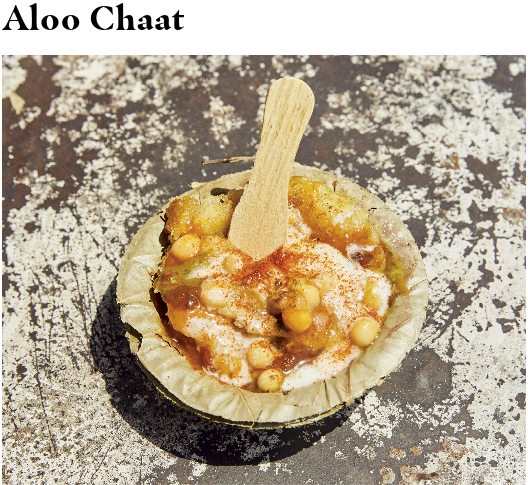
And for those unfamiliar with train journeys in India and their utter madness, drama, and romance, she provides a brief perspective: India’s railway system boasts 40,000 miles of tracks and a mind-boggling 7,500 stations. Combine that with the variety of regional cuisines, and one can only imagine the endless adventures for the foodie that these stations offer. Chauhan traveled with her co-author Jody Eddy on many different trains from unique ones to standard trains, often in third class. They made their first trip to India a decade ago and kept a running tally of the chaat they ate over the journeys—it was close to 600 dishes!
[Left] Aloo Chaat is a classic ambassador of this genre, considering it is savory, sweet, spicy, tangy, creamy, and crunchy…all rolled into one mouthwatering snack.
In her mapping in the book, the North comprises of New Delhi, Amritsar, Srinagar, Agra, and Lucknow; the west is Jaipur, Mumbai Goa, Pune, and Ahmedabad; the east is Puri, Guwahati, Kolkata, and Ranchi; and the south is Chennai, Hyderabad, Mangalore, and Ernakulam. That’s a lot of mouthwatering regional varieties to explore!
Chauhan, who grew up in many different parts of India, is no stranger to the delights of street food or the larger delight of combining it with train travel. A foodie since birth, she once told me of how she ate up her sister’s paratha while still a toddler in the crib!
“I grew up in the small town of Ranchi, the capital of the state of Jharkand, famed for its malpua, the crispy spiced pancakes drenched in sugar syrup,” writes Chauhan.
“Every summer, my family embarked upon a long train ride to the steamy town of Bangalore in southern India to visit my maternal grandparents. For our winter holidays, the train took us north to my paternal grandparents’ home in Ludhiana, in the state of Punjab.”
“No matter whether we went north or south, our train journeys required two to three days of jangling over long stretches of rough steel tracks. The journey was typically a long, cramped, sweaty endeavor, but I never complained. This is because I knew every station delivered an endless picnic of chaat that my parents would customarily indulge us in.” She says, “Feasting aboard the trains of India left an indelible mark upon me and these culinary experiences substantially influenced my decision to devote my life to food.”
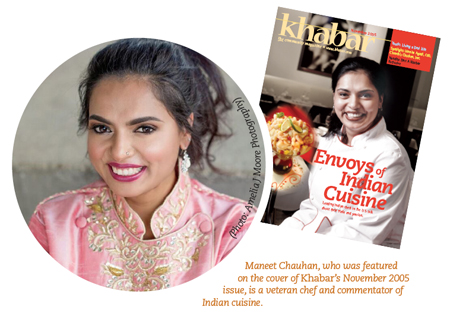
These adventures in eating aboard the trains and the stations of India ignited her love for food. Her learning in creating gastronomy delights started early as a child, by observing a bhel-puri walla at the Ranchi train station, pushed and shoved by a multitude of passengers.
This love has become her life’s work—she is the chef and owner, along with her husband Vivek Deora, of several restaurants in Nashville, Tennessee— Chauhan Ale & Masala House, Tansuo, The Mockingbird, and Chaatable. She’s a James Beard Award- winning chef and also a celebrity judge on Food Network’s show, Chopped.
Besides the entertaining writing, the book has maps and photographs not only of the food but also of the ambience of the train stations, getting you to small towns and sleepy stalls which you may never see in your own rushed visits to the homeland.
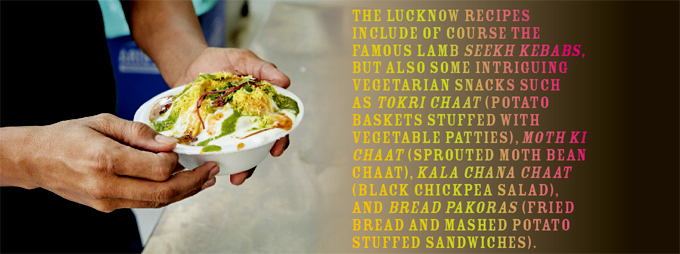
The same goes with Raj Kachori, a version of Khasta Kachori. Chaats manage to be both: comfortably familial, but also distinct and varied—thanks to the combination of standard flavorings paired with varied base ingredients.
Have you ever been to the Old Junction Station in New Delhi? If you’re usually traveling by plane, you may never have encountered this busy train station which was built in 1903 and sees nearly 200,000 passengers every day. With Chauhan as tour guide, you learn that the station is just 20 minutes away from Chandni Chowk, a market established by Emperor Shah Jahan. It is a carnival of every type of chaat, with many of the recipes and shops dating back centuries. Writes Chauhan, “There are more than three centuries of history represented in every chaat you encounter. Mughlai cuisine has deep roots in the chaat recipes of Delhi.” In this Delhi section you learn how to make aloo chaat, aloo tikki chole chat, shakarkandi chaat, as well as a variety of chutneys which give the soul to these snacks.
As you travel with Chauhan through India, you learn the delights of each place. In Punjab, you learn to make the perfect sarson ka saag (spicy mustard greens) and Amritsari Fish (served even at the Amritsar train station). You also visit Punjab’s milk bars to try their flavored milk blended with ingredients like pistachios, saffron, and fresh fruit like papayas and pineapples. Says Chauhan, “A few Indian milk bars, such as Verka and Khangura, have become famous and are must-visit destinations immediately upon stepping off the train.”
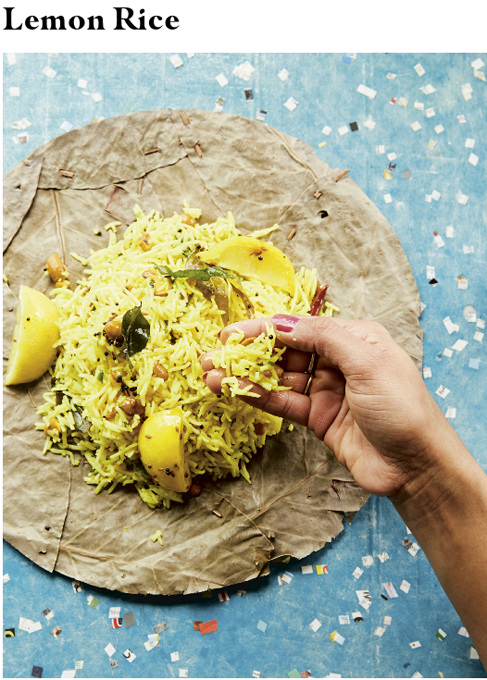
The food odyssey continues. In Kashmir, you feast on Nadir Monji (spicy crispy fried Lotus Root), a vegetarian snack that I’ve never tried. You also feast on Kashmiri Lamb Yakhni, and Tabakh Maaz which are dishes from the traditional Wazwan feast, followed by Kashmiri Kahwa tea.
[Left] Lemon Rice—a southern classic.
You then reach Lucknow where Chauhan’s love affair with kebabs began. She relates, “Lucknow’s largest train station, Charbagh, first started receiving trains in 1867. It’s as famed for the white Mughal inspired minarets that grace its red brick façade as it is for the kebab vendors lined up outside the station, whose skewers of minced meat sizzle over open flames that keep burning from sunrise to well after sunset.” The Lucknow recipes include, of course, the famous lamb Seekh Kebabs, but also some intriguing vegetarian snacks such as Tokri Chaat (potato baskets stuffed with vegetable patties), Moth Ki Chaat (sprouted moth bean chaat), Kala Chana Chaat (black chickpea salad), and Bread Pakoras (fried bread and mashed potato stuffed sandwiches).
The Western India segment includes such want-to-go places as Jaipur, Mumbai, Goa, Pune, and Ahmedabad. Chauhan—consummate traveler that she is—always manages to unearth unknown stories which enrich us. She writes, “One of my favorite places to discover chaat is at the Gandhi Nagar railway station in the Bajal Nagar neighborhood of Jaipur. It’s one of the only railway stations in India operated entirely by women. As an Indian woman who had to fight and claw her way through a male-dominated industry to find success, I am in awe of the forty women who run Gandhi Nagar.”
Mumbai is, of course, the home of street food favorites like bhel puri, vada pav, Mumbai Falooda, and Bombay Sandwich. Chauhan shares the recipes for these must-haves, including that of Bombay Ice Halwa, a sweet which is also known as Paper Halwa, and even Mahim Halwa after the neighborhood where it was invented.
The Goa segment will be an eye-opener because many of us may not have cooked Goan dishes or eaten that cuisine. “My trips to Goa as a child and later as a college student were integral to shaping my conviction that recipes do not have to exist in geographical silos,” she writes. “From the sixteenth century to the early twentieth century, Goa was a colony of Portugal, resulting in a cuisine heavily influenced by both Indian
and Portuguese culinary practices, which fused over the centuries into a cuisine that is singularly Goan.”
The dishes Chauhan introduces you to include Ros Omelette (omelette with tomato gravy), Fish Reeheado (fried fish stuffed with chilli paste), and Potato Egg Chutney Chops (Goan Scotch Eggs).
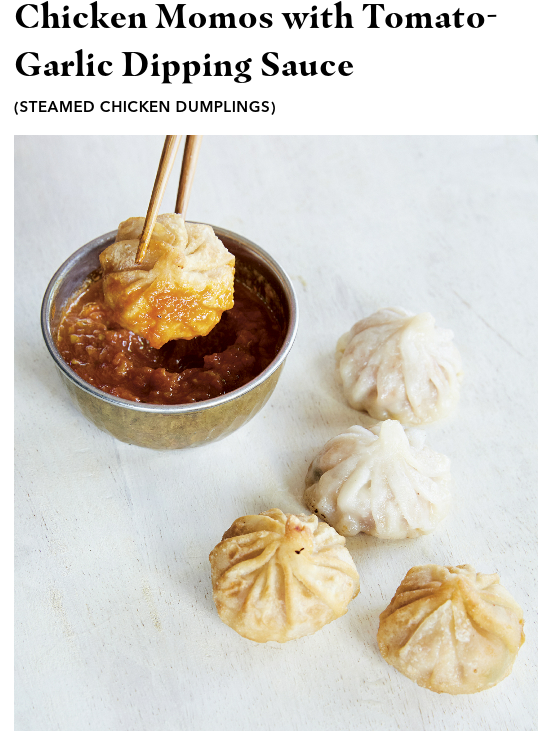
The joy of this book is Chauhan’s chatty style as she relates her many foodie adventures, be it gleaning some wisdom from a Gujarati matriarch who, along with the recipe for Khandavi rolls, also told her, “We Gujaratis believe in living simply because the most beautiful things are waiting to be discovered when life is lived with an uncluttered mind. The same is true for our cooking. Remove the obstacles and anything that is not absolutely necessary, and you will understand the secret of Gujarati cooking.”
As a vegetarian, I drooled over the photographs of Maharashtrian favorites like Kanda Bhajji (crunchy onion fritters) and Kande Pohe (flattened rice pilaf) and Gujarati hits like Panki (banana- leaf-wrapped yogurt and rice pancakes), Khaman Dhokla (fermented chickpea flour cakes), Khandvi (chickpea flour and buttermilk rolls).
But then Chauhan takes you South and shares yet more alternatives. She takes you on train rides to Chennai, Hyderabad, Mangalore, and Ernakulam—the heaven of Idli Chaat, Neer Dosa (literally, water crepe—called so because of its watery batter), Tuppa Dosa (fermented dal and rice crepe), Hyderabadi Chicken Biryani, and Lukhmis (lamb samosas). Mangalore has Goli Baje (crispy fried fritters) which I’ve never tried. She has many tales to tell of Kerala and its special dishes including the famous Kerala Fish Fry. All these make you realize the endless potential and diversity of every Indian city.
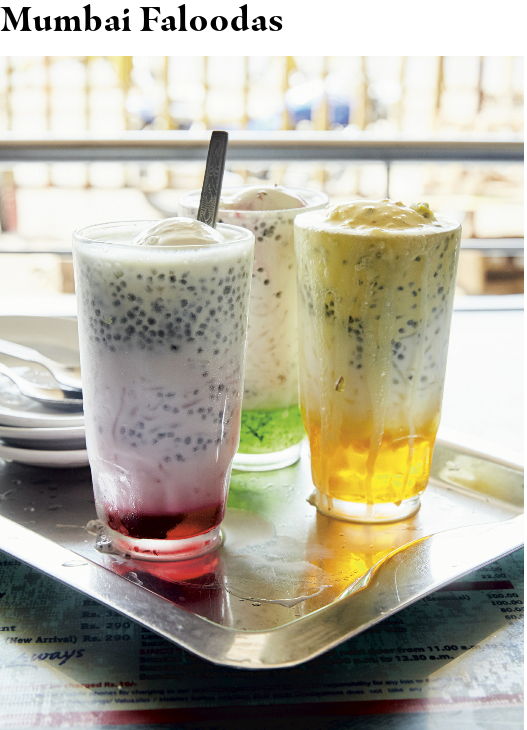
We finally conclude the train journeys with the East—Puri, Guwahati, Kolkata, and Ranchi. The travelogue here is particularly enlightening because many of us may not have traveled east as much (except for Kolkata) unless our hometowns happen to be there, and you already are familiar with snacks like Puchkas, Jhal Muri, and Corn Chaat. Chauhan relates anecdotes about the seashore city of Puri which is an 11-hour train ride from her hometown of Ranchi, and as always, food colors her tales, from the delights of Ghugni Chaat which is sprinkled with the region’s famous spice blend, bhaja masala, to the unique temple food which includes the amazing Maha Prasad consisting of 56 dishes.
You will encounter many new dishes such as Thukpa, the Himalayan chicken noodle soup in Guwahati, and other similar dishes which are actually very old but may be new to us. As she explains, Tibetan, Nepalese, Bhutanese, and Burmese traditions are suffused in Guwahati cuisine as she goes on to share recipes for Aloo Pitika (mashed potatoes with green chilies and onions), Chicken Momos, and Chicken Bamboo Curry.
[Top] Falooda—Mumbai’s heavenly ice-cream based dessert drink: a perfect finish to any chaat.
Combining food and travel, Chauhan takes you to meet the dabbawallas made famous by Harvard’s case study of their supply chain management, as well as railway porters. She also shows you how to make the basics—a multitude of Indian breads, rice, the ubiquitous paneer, and even ghee.
This is just a quick flash—a short train ride as it were—through Maneet Chauhan’s book. Chaat leaves you very hungry but very excited to make things happen in your own kitchen with the recipes at hand. It also gets you dreaming of train travel and adventures waiting at every stop, with the vendors calling out their delicious wares. It encourages you to take your own journeys through India via recipes, spices, and the special romance of Indian railways.
Lavina Melwani is a NY-based journalist who blogs at Lassi with Lavina. Follow her @lavinamelwani.

CHAAT Party
INGREDIENTS:
• Coarsely chopped tomatoes, cucumbers, pineapple, mangoes, potatoes, roasted sweet potatoes, coriander, and mint
• Finely chopped onions, tomatoes, cucumbers, ginger, red and green chiles, scallions, and radishes
• Lemon and lime wedges
• Roasted corn kernels
• Star fruit slices
• Tamarind, cilantro-mint, and green chile chutneys*
• Raita (whole milk yogurt whisked together with water to make it thin enough to drizzle and then seasoned with salt and freshly squeezed lemon juice)
• Roasted peanuts and cashews
• Puchkas
• Puffed rice
• Sev
• Chakri (chickpea flour crackers)
• Chekkalu (rice flour crackers)
• Thattai (spiced rice flour and sesame crackers)
• Namak para (spiced whole wheat flour crackers)
• Murruku (wheat flour crackers)
• Chaat masala
• Red chile powder
METHOD:
Put each item in an individual bowl alongside a stack of larger bowls to enable your guests to mix up their chaat with a spoon or, more traditionally, their hands. If you are able to source banana leaves, I would spread them out over the table before arranging everything else for a bright pop of color.
*Creativity should be the driving force when deciding what ingredients to bring to the table.There is no limit except your imagination when it comes to ingredients, but some suggestions are above.
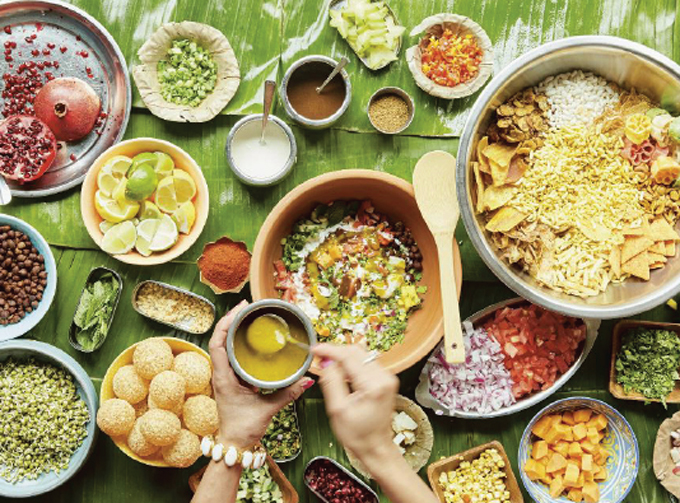
RECIPES
TAMARIND CHUTNEY
INGREDIENTS:
• 1 tablespoon vegetable oil
• 1 teaspoon cumin seeds
• 1 teaspoon coriander seeds
• 1 teaspoon fennel seeds
• 1 teaspoon red chile flakes
• 1 tablespoon finely chopped fresh ginger
• ¼ cup golden raisins
• ¼ cup pitted dates, coarsely chopped
• 1 (16-ounce) block seedless tamarind pulp, coarsely chopped
• 1 cup jaggery or dark brown sugar
• 1 teaspoon chaat masala
• ½ teaspoon black salt (kala namak)
• 1 teaspoon ground ginger Kosher salt
METHOD:
In a sauté pan, heat the oil over medium heat until it glistens, about 2 minutes.
Add the cumin, coriander, fennel, and chile flakes and sauté until aromatic, about 2 minutes. Add the fresh ginger, raisins, dates, tamarind, and jaggery, increase the heat to medium-high, and bring to a boil. Reduce the heat to medium and cook until the sauce is thick and coats the back of a spoon, about 10 minutes, stirring with a wooden spoon occasionally to prevent scorching and to encourage the flavors to mingle. Remove the pan from the heat and stir in the chaat masala, black salt, and ground ginger. Transfer the chutney to a food processor or blender and blend on high speed until smooth. Taste and season with salt. The chutney will keep in a covered container in the refrigerator for up to 2 weeks.
RECIPES
CILANTRO-MINT CHUTNEY
INGREDIENTS:
• 1 cup tightly packed fresh cilantro leaves
• 1 cup tightly packed fresh mint leaves
• Pulp from 1 small mango (about ¼ cup)
• 5 serrano chiles, seeded
• ¼ cup fresh lime juice, plus more to taste
• Kosher salt
METHOD:
In a food processor or blender, combine the cilantro, mint, mango, chiles, lime juice, and salt to taste and blend at high speed until smooth.
Add water as needed to achieve a thick and slightly chunky consistency.
Adjust the seasoning with lime juice and salt as needed.
RECIPES
GREEN CHILE CHUTNEY
INGREDIENTS:
• 2 tablespoons chana dal
• ½ teaspoon ground cumin, roasted
• ½ teaspoon sugar
• ½ teaspoon kosher salt, plus more to taste
• 1 teaspoon chaat masala
• Pinch of hing (asafetida)
• 1 tablespoon fresh lemon juice, plus more to taste
• ½ cup tightly packed fresh mint leaves
• 1 cup tightly packed fresh cilantro leaves
• 3 garlic cloves
• 3 serrano chiles, seeded
• 3-inch knob fresh ginger, peeled with a spoon and coarsely chopped
METHOD:
Heat a cast-iron pan over high heat until nearly smoking. Add the dal and toast, swirling the pan the entire time, until it takes on a light golden-brown color. Immediately transfer the dal to a bowl or onto a plate to prevent it from over toasting. In a food processor, combine the toasted dal and the rest of the ingredients and blend until quite smooth (it will still be a little chunky). Add water, 1 tablespoon at a time, to achieve a thick consistency that holds together on a spoon and is not runny. Taste and season with additional salt and lemon juice according to taste.

SHAKARKANDI CHAAT
(SWEET POTATO AND STAR FRUIT CHAAT)
This is one of the first chaat vendors that I seek out when I step off the train at Old Junction in Old Delhi. There’s almost always one waiting for me with his simple folding stand holding a large metal bowl filled with roasted sweet potatoes, their skins charred from being cooked over a wood fire, alongside a smaller bowl overflowing with vivid green star fruit. You need to try this chaat to believe that crunchy star fruit and creamy roasted sweet potatoes were made for one another.Chaat masala and a squeeze of lemon add depth and vibrancy and coax these two ingredients together to form one of Delhi’s simplest yet most unique chaat recipes. It’s traditionally served in a tiny palm-frond bowl with a toothpick as a utensil. Simple to prepare, healthy, colorful, and fun to eat, I like nothing better than surprising friends who are new to the chaat game with this brilliant (and brilliantly easy) recipe.
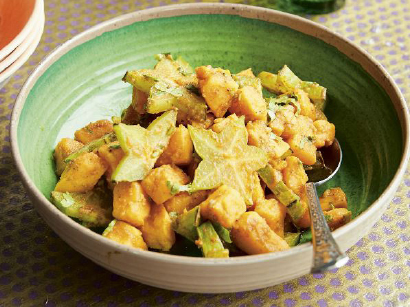 RECIPES
RECIPES
SERVES 6
INGREDIENTS:
• 3 large sweet potatoes
• Vegetable oil, as needed
• Kosher salt
• 2 star fruit, thinly sliced crosswise
• 2 teaspoons chaat masala, or more to taste
• 1 tablespoon finely chopped cilantro
• ½ teaspoon red chile powder
• Juice of 1 lemon, or more to taste
INSTRUCTIONS:
Preheat the oven to 425°F.
Rub each sweet potato with oil and prick all over with a fork, then sprinkle them all over with salt. Wrap each potato individually in foil and roast until tender, 45 to 55 minutes.
Once the potatoes are cool enough to handle, peel them and cut into 1-inch cubes. In a large bowl, toss the sweet potatoes with the star fruit, chaat masala, cilantro, chile powder, and lemon juice until everything is well coated. Serve while the potatoes are still warm, preferably with toothpicks.

PRAWN RISSOIS
(FRIED SHRIMP TURNOVERS)
We have the Portuguese to thank for these addictive fried turnovers stuffed with shrimp. They are essentially the Goan version of an empanada, and I would suggest doubling the batch because they go fast. They can be prepared ahead of time up to the stage of frying and refrigerated in a covered container for up to 1 day. Serve with a variety of chutneys for dipping. I love picking these up at the station and stuffing them into my bag for the long journey ahead of me. They’re so portable and even taste good cold. In America, I love bringing them to potlucks, serving them at summer picnics, or piling a plate with them at birthday parties.
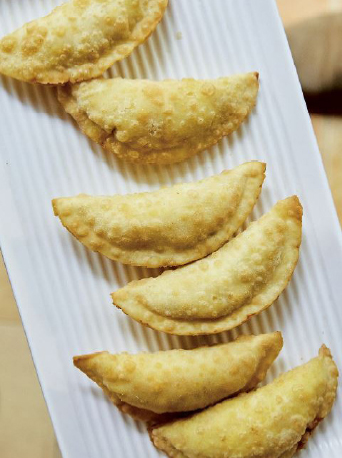
RECIPES
SERVES 6
FILLING:
• 1 tablespoon unsalted butter
• 1 small yellow onion, finely chopped
• 1 teaspoon minced garlic
• 1 pound medium to large shrimp, peeled, deveined and coarsely chopped (about 1½ cups)
• ¾ cup whole milk
• Salt and freshly ground black pepper
• 1 tablespoon all-purpose flour
• ¼ cup shredded Cheddar cheese
• ¼ teaspoon freshly grated nutmeg
PASTRY
• 2 cups whole milk
• 3 tablespoons unsalted butter
• 2 cups all-purpose flour, plus more for kneading and shaping
• Kosher salt
• Vegetable oil, for the bowl
FOR ASSEMBLY AND SERVING
• 2 large eggs
• 1 cup dried bread crumbs
• Vegetable oil, for deep-frying
• Kosher salt
• Chutneys or dipping sauces, as desired
Make the filling: In a sauté pan, melt the butter over medium heat. Add the onion and garlic and sauté until the onion is translucent, about 5 minutes. Add the shrimp and sauté, stirring often, until they turn light pink, 3 to 4 minutes. Stir in the milk and season with salt and pepper to taste.
In a small bowl, stir together the flour and 1 tablespoon water to make a slurry. Add the slurry to the shrimp and cook, stirring occasionally, until the liquid is slightly thickened, 3 to 5 minutes. Remove from the heat and stir in Cheddar and nutmeg. Refrigerate until chilled.
Make the pastry: In a saucepan, combine the milk and butter and cook over medium-high heat, stirring occasionally with a wooden spoon to prevent the milk from scalding. Once the butter is melted, reduce the heat to medium, add the flour, season with salt, and, stirring constantly, cook until a smooth dough forms and it comes together in a ball and begins to pull away from the side of the pan, 5 to 8 minutes. Tend to the mixture carefully during this process to prevent it from burning; if it becomes too hot and begins to burn before coming together and clearing the sides of the pan, remove the pan from the heat for 30 seconds to cool the dough, then reduce the heat and set the pan back over the heat, stirring until a dough forms. Once a dough forms, turn it out into a bowl and set aside until it’s cool enough to handle. Once the dough has cooled enough to handle (but is still warm), dust a clean work surface with flour and knead the dough until it’s smooth and springs back when poked with your finger, 4 to 6 minutes. Oil a medium bowl, add the dough, cover with a damp towel, and set aside for 30 minutes.
All recipes reprinted with permission from Chaat by Maneet Chauhan and Jody Eddy copyright © 2020. Photographs by Linda Xiao. Published by Clarkson Potter, a division of Penguin Random House, LLC.
Enjoyed reading Khabar magazine? Subscribe to Khabar and get a full digital copy of this Indian-American community magazine.
blog comments powered by Disqus










